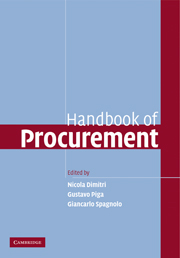Book contents
- Frontmatter
- Contents
- List of figures
- List of tables
- List of contributors
- Preface
- Part I Preliminary Issues
- Part II General Strategic Principles
- Part III Competitive Tendering Strategies
- Part IV Attracting and Screening Participants
- Part V Preventing Collusion and Corruption
- 14 Preventing collusion in procurement
- 15 Bidding rings and the design of anti-collusive measures for auctions and procurements
- 16 Corruption in procurement auctions
- Part VI Dynamic Forces and Innovation
- Glossary
- Index
- References
14 - Preventing collusion in procurement
Published online by Cambridge University Press: 04 November 2009
- Frontmatter
- Contents
- List of figures
- List of tables
- List of contributors
- Preface
- Part I Preliminary Issues
- Part II General Strategic Principles
- Part III Competitive Tendering Strategies
- Part IV Attracting and Screening Participants
- Part V Preventing Collusion and Corruption
- 14 Preventing collusion in procurement
- 15 Bidding rings and the design of anti-collusive measures for auctions and procurements
- 16 Corruption in procurement auctions
- Part VI Dynamic Forces and Innovation
- Glossary
- Index
- References
Summary
The system of sealed bids, publicly opened with full identification of each bidder's price and specifications, is the ideal instrument for the detection of price-cutting.
(Stigler, 1964, p. 48.)Introduction
Competitive procurements are commonly designed to select the most efficient contractor in a pool of competing firms and to maximize the buyer's savings. Competition is not, however, firms’ preferred scenario. Firms dislike cutthroat behaviour. They would rather coordinate their actions in order to soften price competition and raise joint profit. Coordination, whether explicit or tacit, is both tempting and feasible since most procurements are repeated over time. In oligopolistic markets it typically takes a rather simple form. Firms set a high price and keep it stable over time only if no one undercuts its rivals at any point in time. Cheating is normally deterred by the threat of a possibly ever-lasting price war. The emergence of ‘bidding rings’ in procurement, that is, collusive agreements in tendering processes, is driven by forces very similar to those governing cartel formation in oligopolistic markets. As Stigler pointed out, transparency of procurement processes may facilitate collusion since a cartel can promptly identify and punish defecting firms.
Successful bidding rings greatly increase supply price or reduce supplied quality at a given price and are therefore a central concern in procurement design. As John Vickers, Chairman of the UK Office of Fair Trade (OFT), puts it with: Collusive tendering deprives customers of the benefits of competition.
- Type
- Chapter
- Information
- Handbook of Procurement , pp. 347 - 380Publisher: Cambridge University PressPrint publication year: 2006
References
- 14
- Cited by

